
March 5, 2024 | 3:12 pm
Table of Contents
Curious if your small business holds enough cash to thrive? Building cash projections
provides clarity on your cash position. Take steps to prepare one for better financial
foresight.
Cash projections are predictions or forecasts of the amount of cash coming in and out of the
business for a specific period. By making cash flow projections, the company can estimate if
they will experience a shortage or surplus in cash and factor that into their
decision-making.
Preparing cash projections involves:
Learn why cash projections are important for your business to thrive. Improve the future of your business by knowing the steps to preparing one.
What is cash flow?
Before discussing cash flow projections, it’s best to understand first what a cash flow is.
Cash flow is the movement or flow of
money in and out of the business. You can compute this
by getting the difference between cash inflows and outflows.
In the book Personal MBA by Josh Kaufman, the author compared the cash flow cycle to running
a bath. To make the water in the tub rise, you must keep adding water while preventing it
from flowing out.
Similarly, you need more cash inflow or revenue in business than outflow or expenses if you
want more cash.
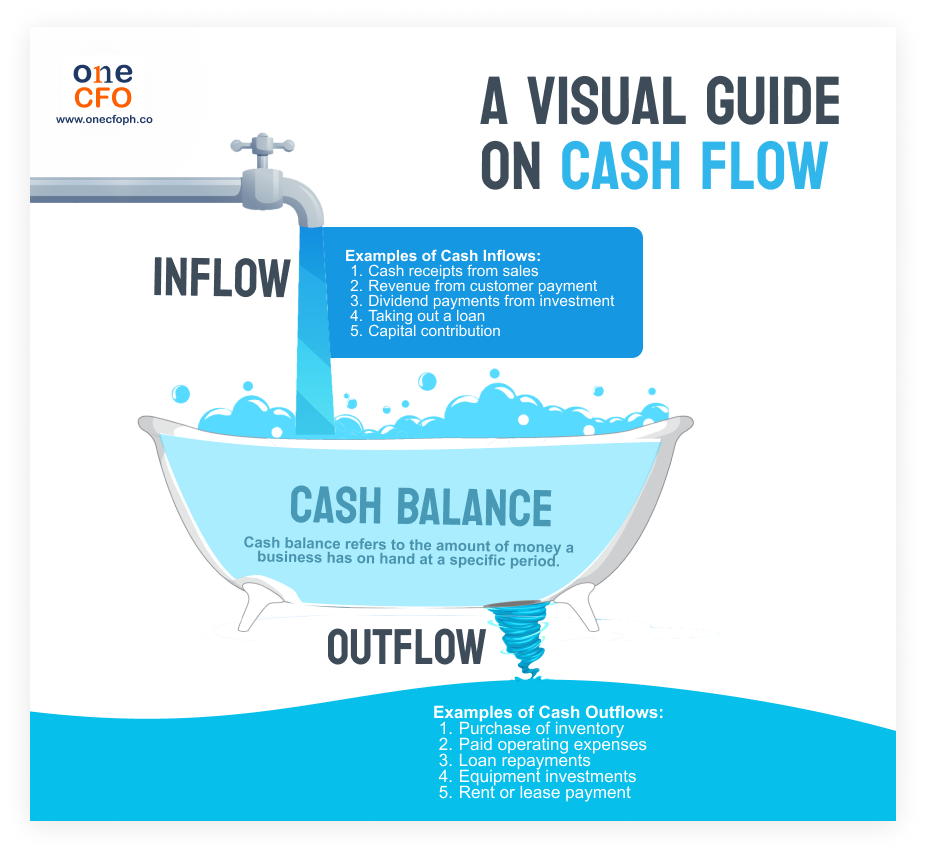
What are the three types of cash flow?
As reflected in cash flow statements, your cash flow transactions can be divided into three types:
The cash flow statement tracks the inflow and outflow of money over a set period. While striving for a positive cash flow is essential, it’s common for small businesses to face challenges with negative cash flow.
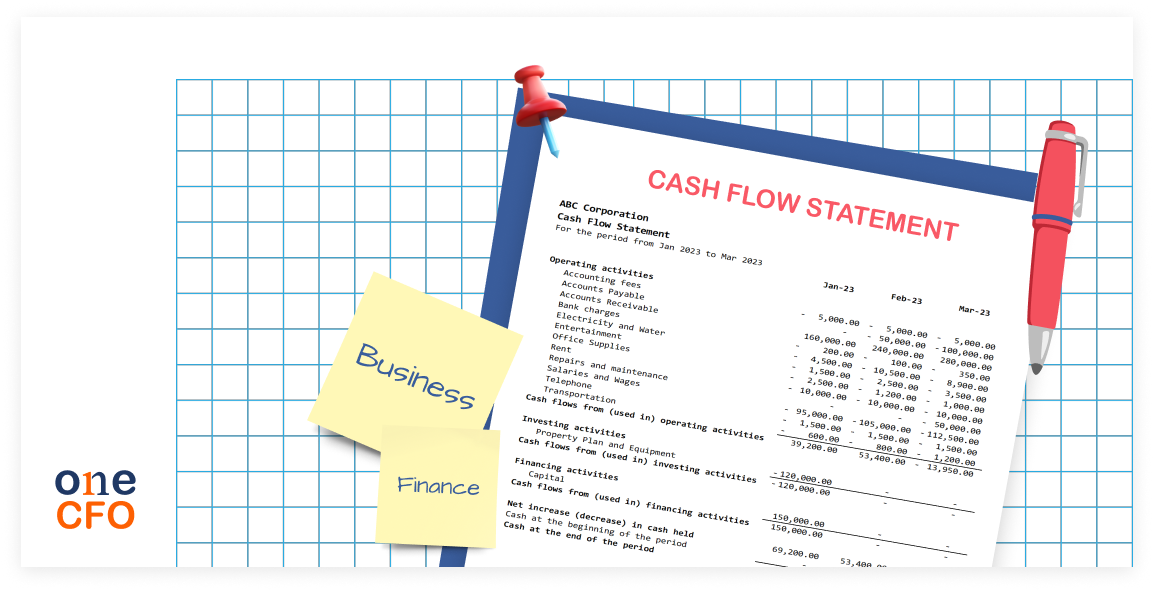
What is negative cash flow?
A negative cash flow happens when a
business spends more money than it makes. It is similar
to using up your allowance faster than you receive it.
Companies should have a positive cash flow to ensure enough cash to cover payables for the
period. However, there are instances when a business experiences negative cash flow.
One scenario is when a company hasn’t received their customers' pending payments. Recording
these receivables in the income statement will make them look profitable on paper, but they
don’t have the cash on hand.
Another common reason for negative cash flow is when the company makes investments that may
take some time to generate inflow. This scenario is common in startups, where they must keep
spending money on growth initiatives.
If inconsistencies in your cash flow happen often enough, this can spell trouble for the
business. Thus, cash flow projections are important to identify potential cash shortfalls in
the coming months.
What is a cash flow projection?
Cash flow projection estimates cash inflows and outflows a small business expects to have
over a certain period. It helps businesses forecast their financial position, anticipate
cash shortages or surpluses, and make informed decisions to manage their finances
effectively.
More established businesses can predict their cash flow for extended periods, such as six
months to a year, since they have more data to back up their estimates.
Meanwhile, it is ideal for newer businesses to project their cash flow weekly or monthly.
Since these businesses have less past data they can use, it would be better to create
forecasts more often to get accurate predictions.
Why is a cash flow projection important to your business?
Creating a cash flow projection is like looking into a crystal ball, predicting your business’ future.
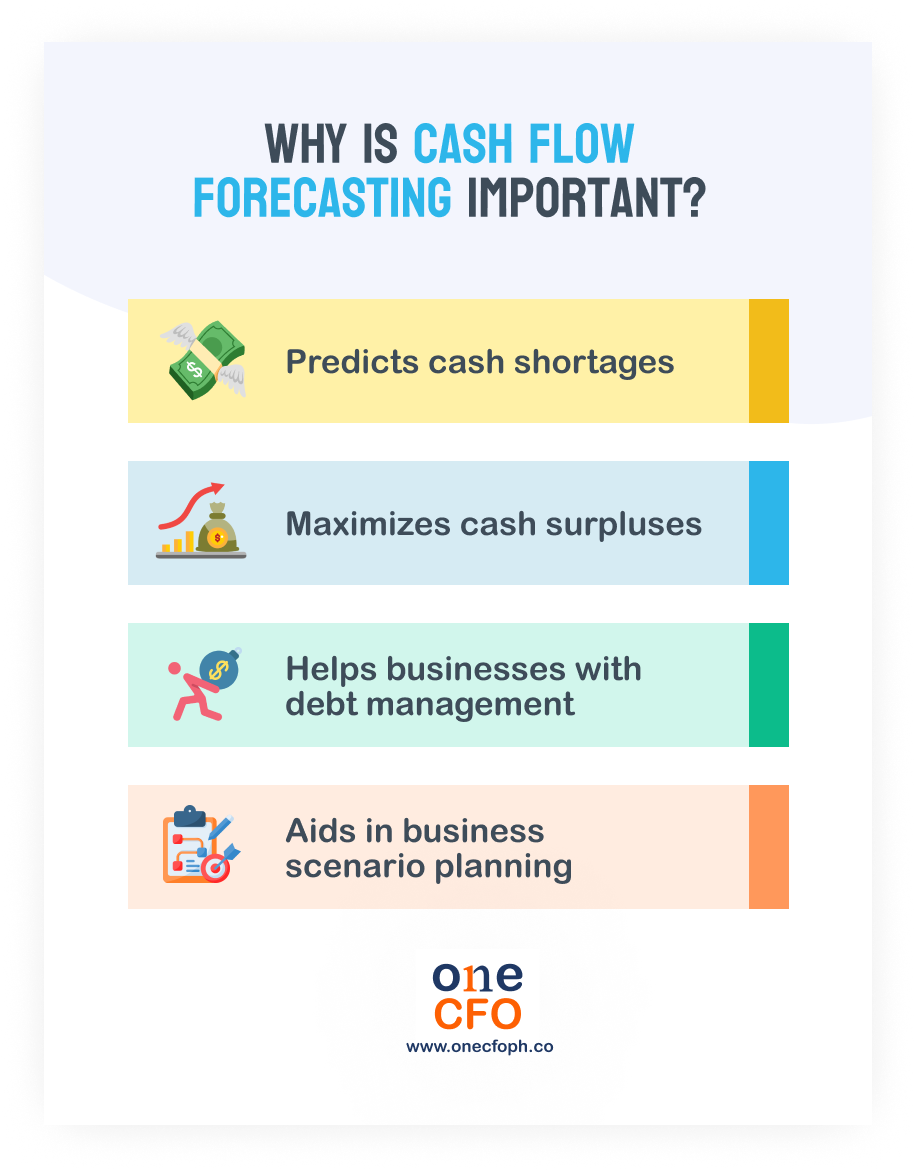
Predicts cash shortages
A cash flow projection helps businesses avoid and remedy shortages that may cause financial
challenges. Owners can check liquidity in the coming weeks or months and the possible
shortfalls before they happen.
Shortages typically happen when there is low customer demand or poor cash flow management.
Other times, a company experiences negative cash flow when it makes significant investments,
such as buying properties, where they tend to spend more money than what they earned for the
period.
Once the company foresees a shortage, the management can find immediate solutions to avoid
the problem quickly.
A business can solve shortages by raising funds, taking loans,
boosting income streams, reducing customers’ payment terms, and negotiating with vendors.
Watch this video to get more insights on how to manage cash flow and avoid liquidity issues:
Maximizes cash surpluses
As financial forecasts predict cash shortages, they can also predict future cash surpluses!
By knowing when the company will likely have a surplus or extra cash, business owners can
strategize on maximizing the situation to their advantage.
For example, entrepreneurs can use cash surpluses to reinvest in the company and boost the
business’s growth. They can do this by hiring more people, purchasing new equipment,
increasing their marketing budget, and more.
Companies can also settle payables in advance to foster better relationships with their
vendors and suppliers.
Debt management
Cash flow projections also help businesses manage their debts in many ways:
Scenario planning
Another advantage of making cash flow projections is the ability to predict your cash flow
in different scenarios.
Businesses can repeatedly tweak their forecasts to depict scenarios like hiring more people
and launching a new product.
On the other hand, they can also plan for not-so-good scenarios like sales dropping by a
certain percentage or losing a specific amount of customers.
By plotting the company's best-case, worst-case, and most likely scenarios, business owners
can better prepare themselves and manage their cash flow accordingly.
Aside from planning different scenarios, businesses can also plan the best time to implement
their decisions.
For example, if a company wants to expand into new markets by building branches in other
cities, it can expand when the business has a cash surplus. By doing so, business owners
won’t risk experiencing shortages while supporting company growth.
How do you make cash flow projections?
Creating cash flow projections helps make better business plans and decisions. Here are the steps to make your cash forecast:
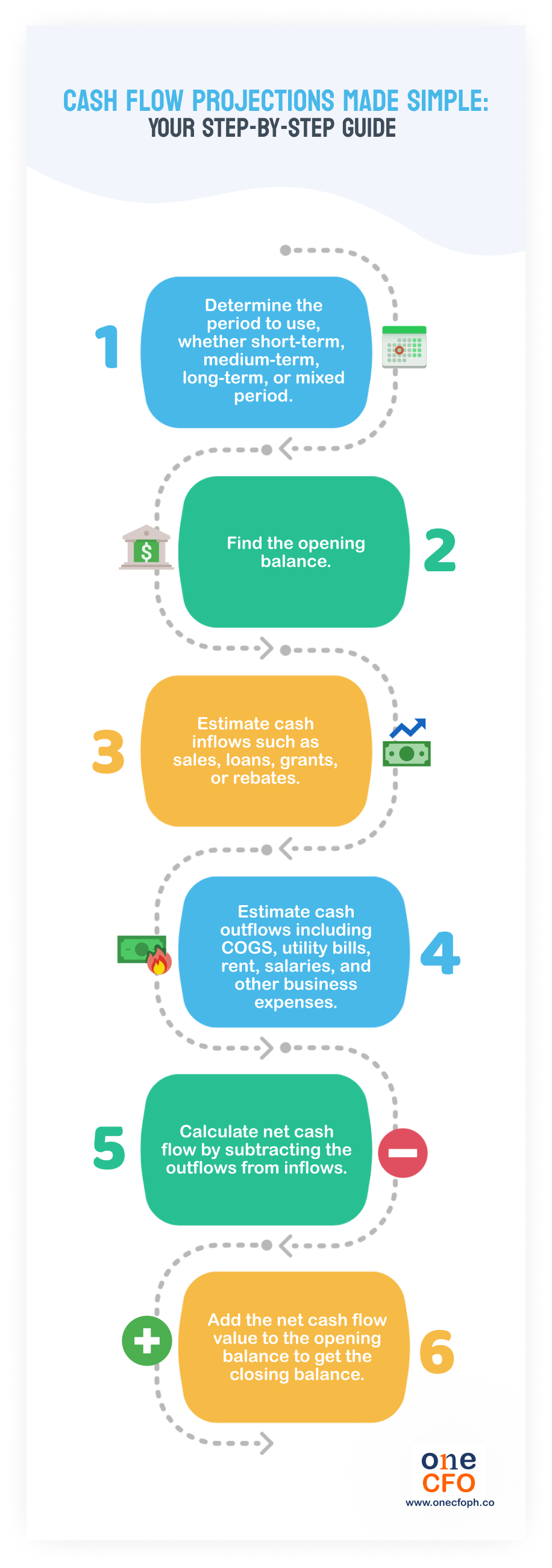
Determine the period to use
The first step in creating cash flow projections is determining the period or how far you
want to look into the future.
It’s also important to remember that there’s a trade-off between the forecast duration and
its accuracy. Predicting too far ahead means you have less information to work with, and the
accuracy or reliability of the forecast is also affected.
Short-term
Forecasts with a shorter period are best for new or small businesses that need to manage
their day-to-day needs. Typically, these businesses can look at short-term liquidity
planning one to four weeks into the future.
Creating short-term projections may require automation in collecting data from
bank
transactions. Accounting software or ERP systems with real-time inflows
and outflows allow
business owners to automatically update their forecasts and create strategies around them.
Medium-term
A medium-term forecast is more suitable when planning for debt or interest payments. This
forecast can be good for two to six months and helps businesses foresee possible liquidity
issues in the coming months.
Companies typically create financial reports for key dates such as month-end or quarter-end.
It’s best to use medium-term forecasting for these kinds of reports since the estimation
period aligns well with the cadence of such reports.
Long-term
Cash projections with a long-term period usually forecast cash flow six to 12 months into
the future.
This long-term projection is suitable for established businesses with more data to use in
the forecast. Having available information reduces the inaccuracies in the projection, even
when it predicts cash flow far ahead.
Long-term cash projections are also used for long-term growth strategies and planning.
When using these projections, businesses look at the bigger picture and use this as a
reference when planning annual budgets or the capital they’ll need for the following year.
Mixed-term
Businesses can also create forecasts with mixed periods as they see fit for the business.
Mixed-period projections are helpful for companies that want to spot potential risks in
liquidity early on.
For example, a new entrepreneur can choose to create a weekly forecast for their first three
to six months in the business. Once they have more information, they may change the forecast
period to monthly or quarterly.
Find the opening balance
After determining the period, you need to find or identify the opening balance for the
forecast. Opening balance is the amount of money the business is starting with.
If the company is new, the opening balance is the investments and capital prepared to run
the business.
On the other hand, businesses that have operated for some time can find their opening
balance by subtracting the previous period’s expenses from their income, as seen in the
formula below. They may also check their balance from their last cash flow statement.
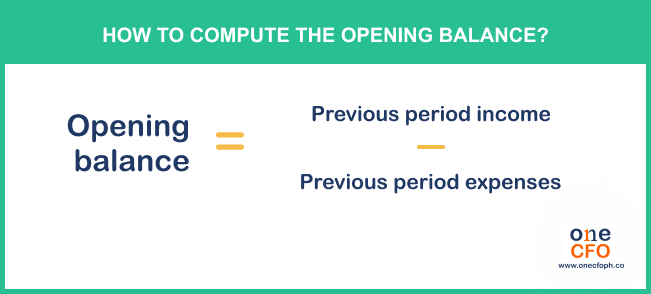
Estimate cash inflows
The next step is to predict how much cash inflows the business will have for the next
period, including revenue or sales, loans, grants, or rebates.
Since cash flows essentially measure how liquid the business is, remember to only consider
on-hand cash or those in the bank account as an inflow. Doing so gives you an accurate
picture of how much cash the business can use now.
To predict the inflows, businesses can look into trends from the previous periods or
estimate based on the current state of the market.
Estimate cash outflows
Likewise, you need to estimate the business’s cash outflows or expenses.
Common business expenses include the cost of goods sold,
utility bills, rent, salary, taxes,
marketing spending, and debt repayments.
Also, consider any one-time or seasonal business expenses like
employee Christmas parties.
A good practice is adding an “Other expenses” category, a buffer in your projection for
unexpected expenses.
Calculate net cash flow
Once you have estimated the total cash inflows and outflows, then simply use the net cash flow formula to compute the net cash flow:

From here, you can easily see whether you will have a positive or negative cash flow.
Compute the closing balance
The final step is to add the calculated net cash flow to the opening balance, giving you the closing balance. See the formula below:
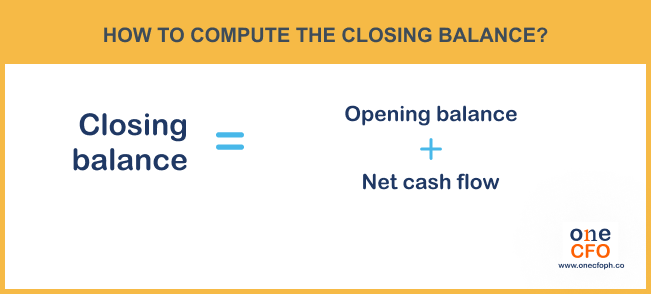
The closing balance gives businesses an overview of how much money they will have remaining after the period. This balance is also the opening balance for the next period’s projection.
Leveraging financial acumen for optimal cash flow projections
Creating cash flow projections can be daunting, especially for small business owners. Aside
from the needed computations, entrepreneurs must also ensure the accuracy of the data they
use and create meaningful insights from their forecasts.
Fortunately, there's a solution that doesn't require small business owners to become
financial experts just to have cash projections - letting pros, such as OneCFO, do the work!
OneCFO is your
outsourced finance department offering tech-enabled bookkeeping, payroll,
tax, and CFO services to small businesses at an affordable price.
In addition, OneCFO’s team of financial experts is also well-equipped to provide your
business with essential reports and insights, like cash projections, helping you build
strategies for long-term growth.
Visit us at onecfoph.co or
contacting us at [email protected] to learn how we can help with your
cash flow projections and optimize your growth.
Read our disclaimer here.